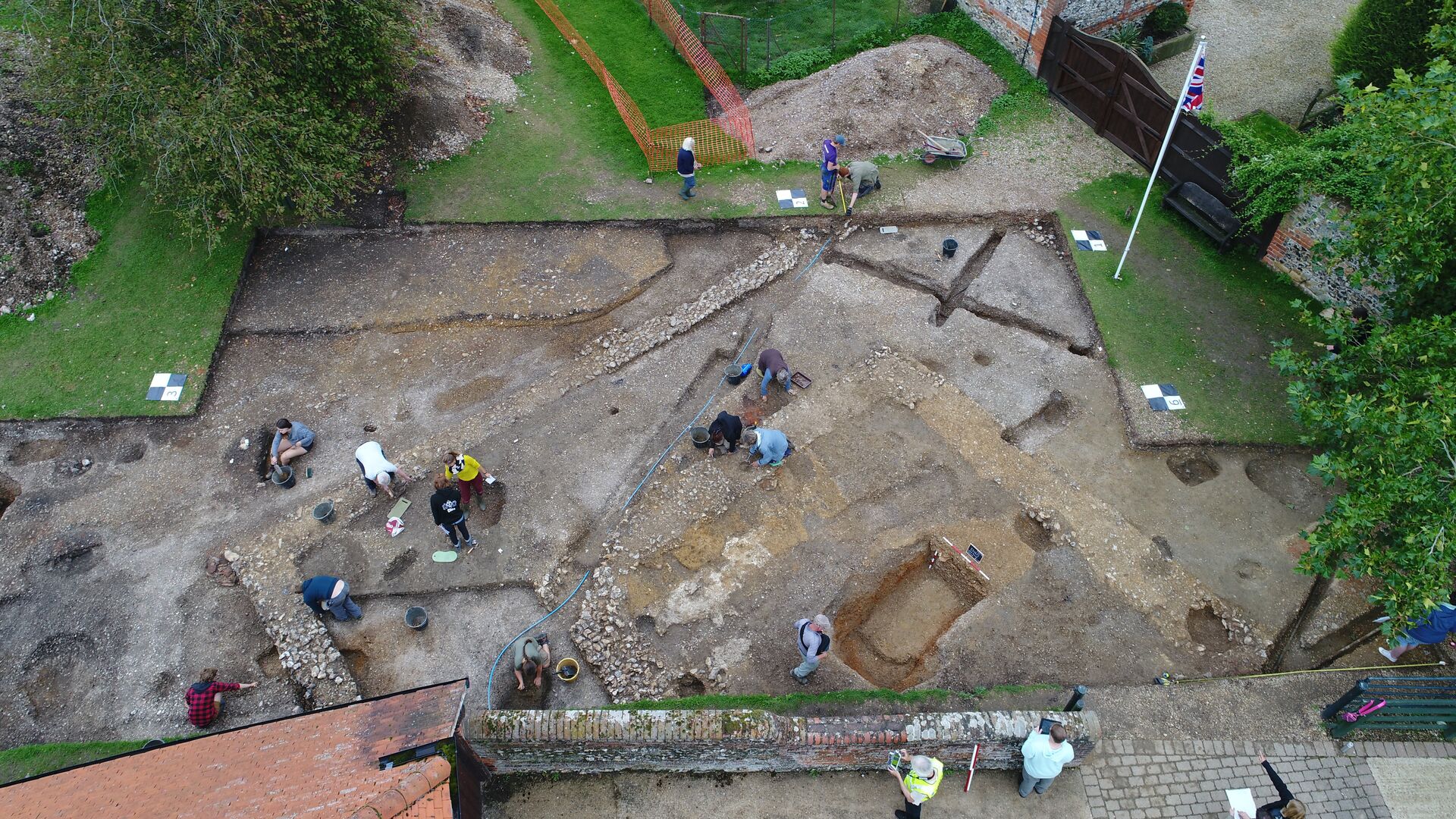https://sputnikglobe.com/20220218/very-special-stamped-tile-offers-archeological-breakthrough-into-past-of-uk-roman-town-1093136079.html
‘Very Special' Stamped Tile Offers Archaeological Breakthrough Into Roman Past of UK Town
‘Very Special' Stamped Tile Offers Archaeological Breakthrough Into Roman Past of UK Town
Sputnik International
Silchester Town, or Calleva Atrebatum as it was once known, is one of the best preserved Roman towns in Britain. It is the location of the University of... 18.02.2022, Sputnik International
2022-02-18T09:26+0000
2022-02-18T09:26+0000
2023-05-28T15:18+0000
roman
united kingdom (uk)
https://cdn1.img.sputnikglobe.com/img/105941/33/1059413387_0:285:5472:3363_1920x0_80_0_0_27c9502b3052fc58b11670df06758dcf.jpg
Archaeologists have been digging at the site of Silchester Roman Town, Hampshire, which is considered one of the best preserved in the UK, for the last 20 summers. They were amazed when they unearthed a "very special" Roman stamp that offered "new information" into the past of the excavation site. The thermal baths, in the southeast of the town, were explored by the Channel 5 documentary ‘Digging for Britain’s Past’, and one of the fascinating discoveries made was a stamped tile with the name and title of the fifth Roman emperor, Nero, full name: Nero Claudius Caesar Augustus Germanicus. The 'Ger' from Germanicus was visible on the stamp. Silchester Roman Town, or Calleva Atrebatum as it was once known, had been the capital of the Iron Age Atrebates tribe from the late 1st century BC. After the Roman conquest of AD 43 it became the large and bustling town of Calleva Atrebatum, which featured shops, homes, public baths and an amphitheatre. It served as a major crossroads in the Roman roads of Britain before it was abandoned between the 5th and 7th centuries AD. Unlike most other Roman towns, it was never re-occupied, lying buried beneath the ground until excavations started. The site, which boasts a complete circuit of the Roman walls, some of the best-preserved town defences in the country, and remains of the amphitheatre, covers an area of over 107 acres (43.3 hectares) within a polygonal earthwork. The area within the walls is now predominantly farmland. The University of Reading has been spearheading a five-year archaeological research project to explore the prehistoric use of the landscape around Silchester. The bronze Silchester eagle, discovered in the Basilica at Calleva in 1866, can be seen in Reading Museum. During excavations in 1893, the Silchester Ogham stone, dated 500 AD, was located. Speaking about the discovery of the stamped tile, Dr Sara Machin, Roman tile expert at the University of Reading, stated in the documentary: Nero ascended to power 11 years after the Roman conquest of Britain. “Because it’s Nero, this gives us a really tight date. It’s very special and gives us so much new information about the bath house than we ever thought we would get,” added Dr. Machin.
united kingdom (uk)
Sputnik International
feedback@sputniknews.com
+74956456601
MIA „Rossiya Segodnya“
2022
News
en_EN
Sputnik International
feedback@sputniknews.com
+74956456601
MIA „Rossiya Segodnya“
Sputnik International
feedback@sputniknews.com
+74956456601
MIA „Rossiya Segodnya“
roman, united kingdom (uk)
roman, united kingdom (uk)
‘Very Special' Stamped Tile Offers Archaeological Breakthrough Into Roman Past of UK Town
09:26 GMT 18.02.2022 (Updated: 15:18 GMT 28.05.2023) Silchester Town, or Calleva Atrebatum as it was once known, is one of the best preserved Roman towns in Britain. It is the location of the University of Reading's Silchester Bathhouse Project, Iron Age Environs Project and Nero at Silchester excavations.
Archaeologists have been digging at the site of Silchester Roman Town, Hampshire, which is considered one of the best preserved in the UK, for the last 20 summers. They were amazed when they unearthed a "very special"
Roman stamp that offered "new information" into the past of the excavation site.
The thermal baths, in the southeast of the town, were explored by the Channel 5 documentary ‘Digging for Britain’s Past’, and one of the fascinating discoveries made was a stamped tile with the name and title of the fifth Roman emperor, Nero, full name: Nero Claudius Caesar Augustus Germanicus. The 'Ger' from Germanicus was visible on the stamp.
Silchester Roman Town, or Calleva Atrebatum as it was once known, had been the capital of the Iron Age Atrebates tribe from the late 1st century BC. After the Roman conquest of AD 43 it became the large and bustling town of Calleva Atrebatum, which featured shops, homes, public baths and an amphitheatre. It served as a major crossroads in the Roman roads of Britain before it was abandoned between the 5th and 7th centuries AD.
Unlike most other Roman towns, it was never re-occupied, lying buried beneath the ground until excavations started. The site, which boasts a complete circuit of the Roman walls, some of the best-preserved town defences in the country, and remains of the amphitheatre, covers an area of over 107 acres (43.3 hectares) within a polygonal earthwork. The area within the walls is now predominantly farmland.
The University of Reading has been spearheading a five-year archaeological
research project to explore the prehistoric use of the landscape around Silchester. The bronze Silchester eagle, discovered in the Basilica at Calleva in 1866, can be seen in Reading Museum.
During excavations in 1893, the Silchester Ogham stone, dated 500 AD, was located. Speaking about the discovery of the stamped tile, Dr Sara Machin, Roman tile expert at the University of Reading, stated in the documentary:
“It’s a full circular stamp that comes round, and it’s got Nero Claudius Caesar Augustus Germanicus.”
Nero ascended to power 11 years after the Roman conquest of Britain.
“Because it’s Nero, this gives us a really tight date. It’s very special and gives us so much new information about the bath house than we ever thought we would get,” added Dr. Machin.



